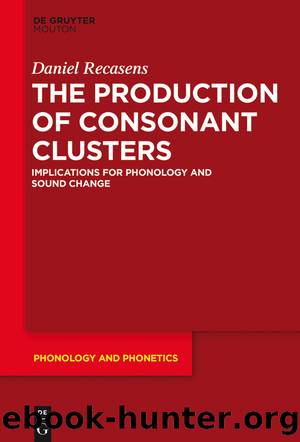The Production of Consonant Clusters by Daniel Recasens

Author:Daniel Recasens
Language: eng
Format: epub
Publisher: Walter de Gruyter
Published: 2018-02-15T00:00:00+00:00
4.1.1.2Labial and lingual
Differences in degree of overlap and assimilation have been reported to occur between sequences composed of labial and lingual stop consonants as well.
In agreement with the coarticulatory resistance hierarchy, greater overlap has been found to occur in sequences with a labial C1 than in those with a velar C1 whenever C2 is a dentoalveolar stop. This difference in gestural overlap holds for /pt/ > /kt/ in Greek (word initially and word medially; Yip, 2013) and in Korean and Russian (word medially and across a word bounday in the former language and in C#C sequences in the latter; Kochetov et al., 2007), and for /phth/ > /gd/ in Georgian (word initially and word medially according to Chitoran et al., 2002 and word initially according to Goldstein et al., 2009). The reverse relationship, i.e., more overlap for /kt/ than for /pt/, has been reported to take place in Portuguese (word medially, Cunha, 2014), though this apparent exception could be attributed to the fact that /kt/ was embedded in longer words than /pt/: (/pt) captar âto catchâ, captador âcatcherâ; (/kt/) compactado âcompactedâ, compactador âcompactorâ.
Regarding stop cluster pairs showing a reverse place combination, a comparison between labial + velar and velar + labial sequences show the expected differences in degree of overlap, namely, /bg/ > /gb/ in Georgian (see above) and in Moroccan Arabic (word medially; Zeroual et al., 2014). More overlap for /bg/ than for /gb/ could be associated with the fact that C1 is labial in /bg/ and velar in /gb/ and also that C2 is velar in the former sequence and bilabial in the latter. Differences in degree of overlap between labial+velar and velar+labial sequences have implications for assimilatory patterns, as revealed by Korean where /pk/ but not /kp/ undergoes regressive assimilation. As to the pairs of sequences with a dentoalveolar and a labial, more overlap has been reported to take place in labial+front lingual clusters than in front lingual+labial ones in Georgian (/phth/ > /thb/, word initially and word medially; Chitoran et al., 2002) and Moroccan Arabic (/bd/ > /db/, word medially; Zeroual et al., 2014). This difference in degree of gestural overlap is not consistent with the trend for /t/ to assimilate to following /p/ and for /p/ to not assimilate to following /t/ in languages like Korean and Catalan (see also descriptive data for Cairene Arabic in section 4.1.1.1), and could be associated with the fast motion of the tongue front articulator for the production of apical and apicolaminal consonants.
The predicted patterns of gestural overlap are also consistent with production data for cluster pairs where C1 remains constant. Thus, in sequences with a labial C1 the consonant is more overlapped by a following velar stop than by a following dentoalveolar stop, as revealed by data taken from Moroccan Arabic (/bg/ > /bd/; Zeroual et al., 2014) and marginally from English (/p#k/ > /p#t/; Gao et al., 2011). In agreement with this pattern of gestural overlap, regressive assimilation in clusters with C1=/p/ applies only when the labial stop precedes /k/ in Korean (Kochetov & Pouplier, 2008, Son et al.
Download
This site does not store any files on its server. We only index and link to content provided by other sites. Please contact the content providers to delete copyright contents if any and email us, we'll remove relevant links or contents immediately.
Cecilia; Or, Memoirs of an Heiress — Volume 1 by Fanny Burney(32434)
Cecilia; Or, Memoirs of an Heiress — Volume 2 by Fanny Burney(31871)
Cecilia; Or, Memoirs of an Heiress — Volume 3 by Fanny Burney(31852)
The Lost Art of Listening by Michael P. Nichols(7406)
Asking the Right Questions: A Guide to Critical Thinking by M. Neil Browne & Stuart M. Keeley(5632)
We Need to Talk by Celeste Headlee(5542)
On Writing A Memoir of the Craft by Stephen King(4863)
Dialogue by Robert McKee(4321)
Pre-Suasion: A Revolutionary Way to Influence and Persuade by Robert Cialdini(4145)
I Have Something to Say: Mastering the Art of Public Speaking in an Age of Disconnection by John Bowe(3840)
Elements of Style 2017 by Richard De A'Morelli(3307)
The Book of Human Emotions by Tiffany Watt Smith(3238)
Fluent Forever: How to Learn Any Language Fast and Never Forget It by Gabriel Wyner(3028)
Name Book, The: Over 10,000 Names--Their Meanings, Origins, and Spiritual Significance by Astoria Dorothy(2939)
Good Humor, Bad Taste: A Sociology of the Joke by Kuipers Giselinde(2903)
Why I Write by George Orwell(2874)
The Art Of Deception by Kevin Mitnick(2736)
The Grammaring Guide to English Grammar with Exercises by Péter Simon(2706)
Ancient Worlds by Michael Scott(2623)
